Get new posts by email or rss feed
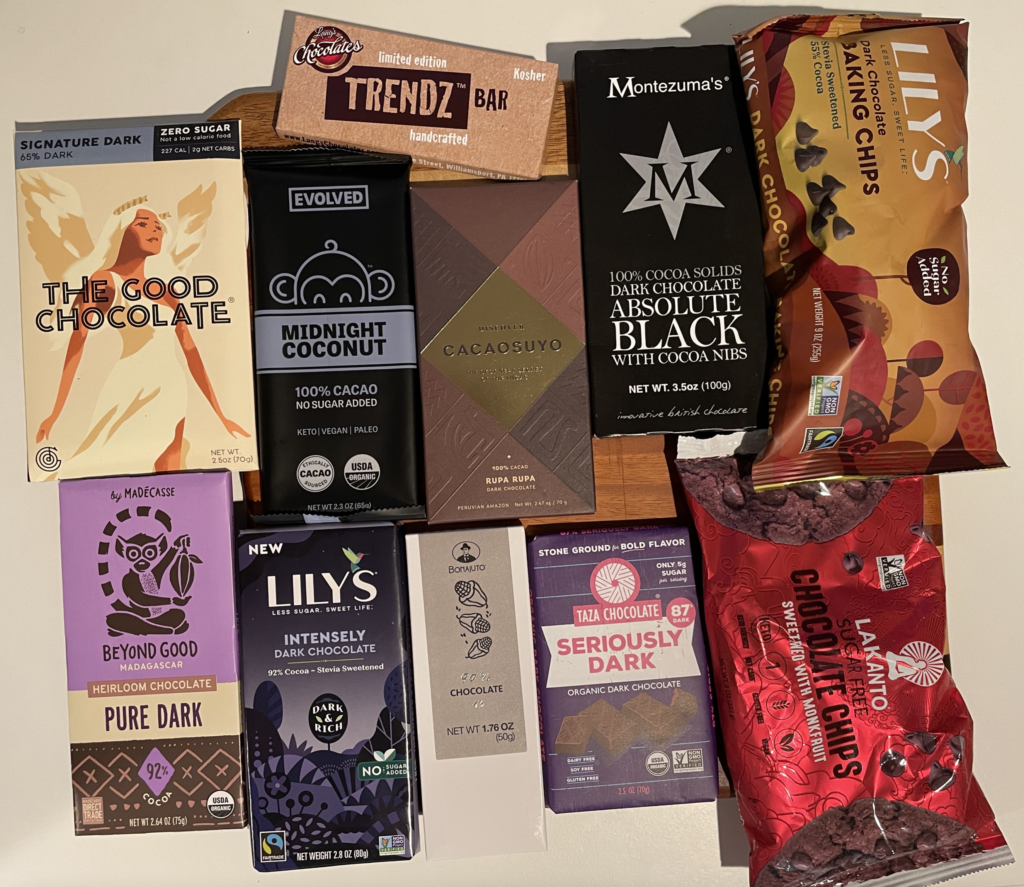
This post is an update on my experiments measuring the effect of low-carb foods and dietary supplements on blood sugar.
This week, I have the results from low-carb chocolates. Next week I’ll starting testing and posting flour replacements and other ingredients.
Testing Queue:
- Prepared foods:
- Tortillas: Reported
- Cereal: Reported
- Ice Cream: Reported
- Bread: Reported
- Meal replacements: in queue, (Ketochow reported)
- Snack bars: in queue
- Chocolate: This post
- Ingredients:
- Flour replacements: in queue
- Seeds & nuts: in queue
- Vegetables: in queue
- Supplements:
- Vinegar: In queue
- MSG: Reported
Chocolate
Summary
Since I’ve started posting these food-effect studies, one of the most requested products has been low-carb chocolate. As with other low-carb products, a ton of new low-carb chocolates have become available. Initially, most used a simple substitution of a non-nutritive sweetener, like erythritol, for sugar. However, I’ve noticed in the last few years, a number of high cocoa/low sugar chocolates that use regular sugar, just in very low quantities (90-100% cocoa).
In both cases, the net carb count can be very low, though this largely relies on subtracting the high fiber content of the cocoa. Since I’ve had very mixed results with the blood glucose impact of dietary fiber (see here & here), I tested them myself.
Towards that end, I tested 13 chocolates from 4 different categories (grouped by sweetener). Here’s my overall conclusions:
- Lowest BG impact: Lily’s Almond Dark & The Good Chocolate Signature Dark
- ~65% of the impact of 100% cocoa bars
- Best combination of taste & impact: Taza Wicked Dark & Trendz Bar
- Chocolate with added fiber shows much higher blood glucose impact
- There’s a significant variation between brands
- This could be due to different fiber type or quantity
- Watch out for the ChocZero chocolate, which gave ~2x the BG impact of the next highest chocolate.
Evidence continues to pile up that there’s a large variation in the impact of different fibers, even ones with the same name listed on the nutrition label. I’m going to see whether I can source a decent variety to test.
If anyone knows where to get the fibers and resistant starches that are used in low-carb prepared foods (especially from the actual manufacturers), please let me know in the comments or by PM.
As always, please let me know if you have any thoughts, suggestions, or anything else you’d like to see me test.
– QD
Details
Purpose
- To identify low-carb foods that taste good and have minimal effect on my blood glucose.
- To determine the effect of popular, literature supported dietary supplements on my blood glucose.
Background
Since I’ve started posting these food-effect studies, one of the most requested products has been low-carb chocolate. As with other low-carb products, a ton of new low-carb chocolates have become available. Initially, most used a simple substitution of a non-nutritive sweetener, like erythritol, for sugar. However, I’ve noticed in the last few years, a number of high cocoa/low sugar chocolates that use regular sugar, just in very low quantities (90-100% cocoa).
In both cases, the net carb count can be very low, though this largely relies on subtracting the high fiber content of the cocoa. Since I’ve had very mixed results with the blood glucose impact of dietary fiber (see here & here), I tested them myself.
Design/Methods
Foods. I tested 13 chocolates from 4 different categories (grouped by sweetener):
- Regular (no non-nutritive sweeteners or added fiber)
- Allulose
- Erythritol & Stevia/Monk Fruit
- Corn Fiber
Full nutrient and ingredient info here. Key nutrition facts in the table below.
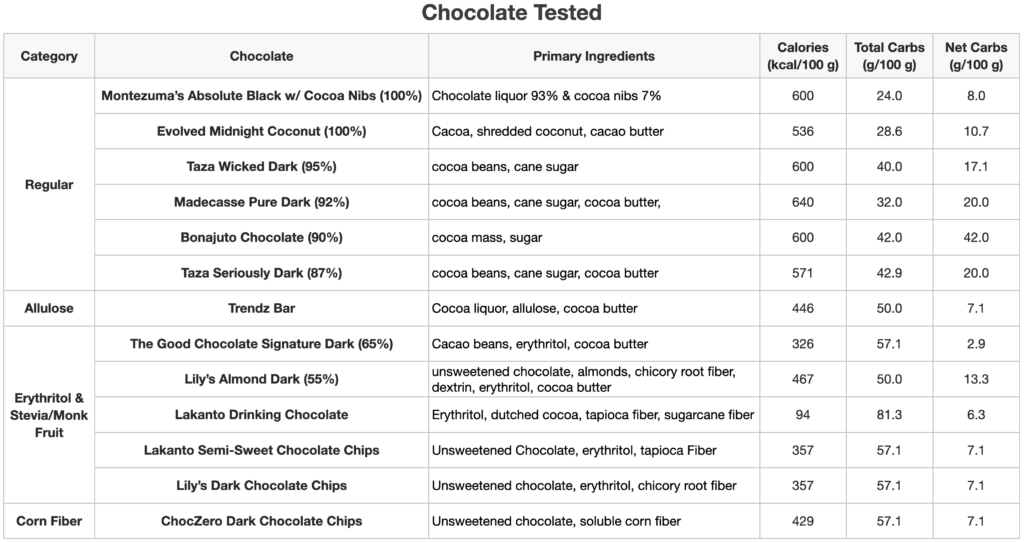
Procedure. At 5:00a, I took 4.5u of Novolog (fast acting insulin, duration of 2-4h), then drank a Ketochow shake (website, BG testing) at 5:30a. After that, no food or calorie-containing drinks were consumed and no exercise was performed. Non-calorie-containing drinks were consumed as desired (water or caffeine-free tea). At 10:30am-12 pm, the substance to be tested was eaten as rapidly as comfortable and notes on taste and texture were recorded (before observing any change in blood sugar).
Blood sugar was monitored for 5h using a Dexcom G6. Calibration was performed 15-30 min. before the start of each experiment.
Data Processing & Visualization. iAUC was calculated using the trapezoid method (see data spreadsheet for details). Data was visualized using Tableau.
Medication. During these experiments, I took long-acting basal insulin each evening at 9pm (Lantus, 1.5u) and 2000 mg of metformin and multivitamin each morning at 5am. I did not dose for the experimental food ingested.
Data
- Formatted raw data, peak blood glucose, iAuC, and time to peak data
- Summary data, ingredient details, and taste assessments
Results & Discussion
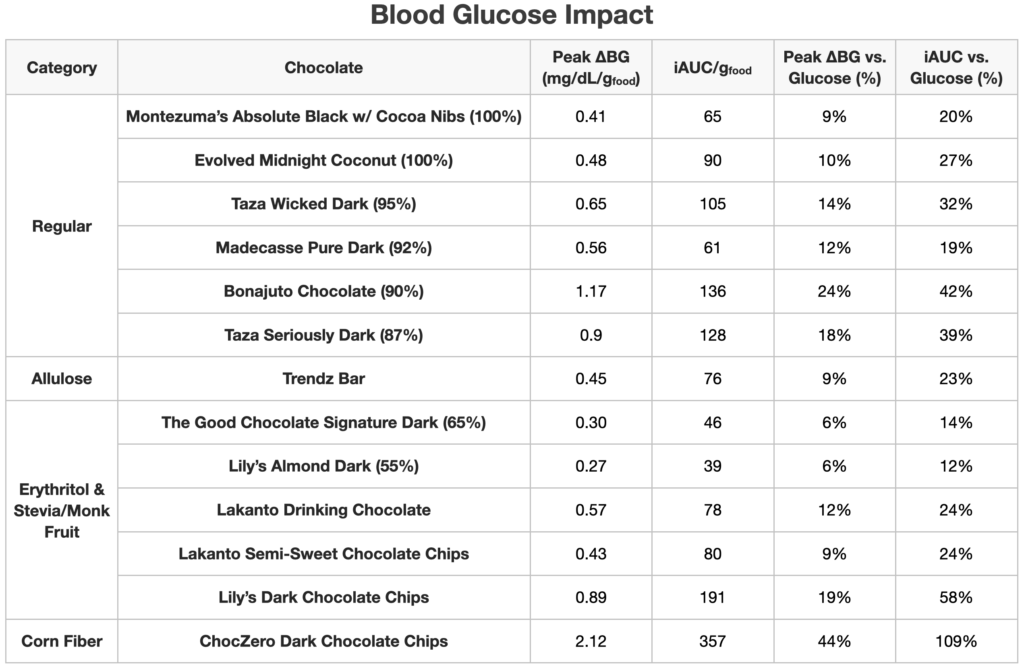
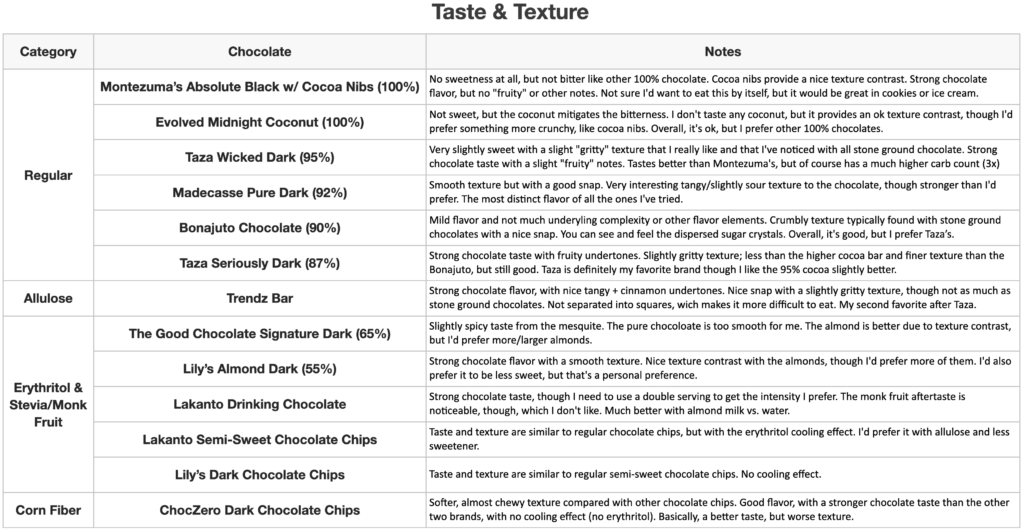
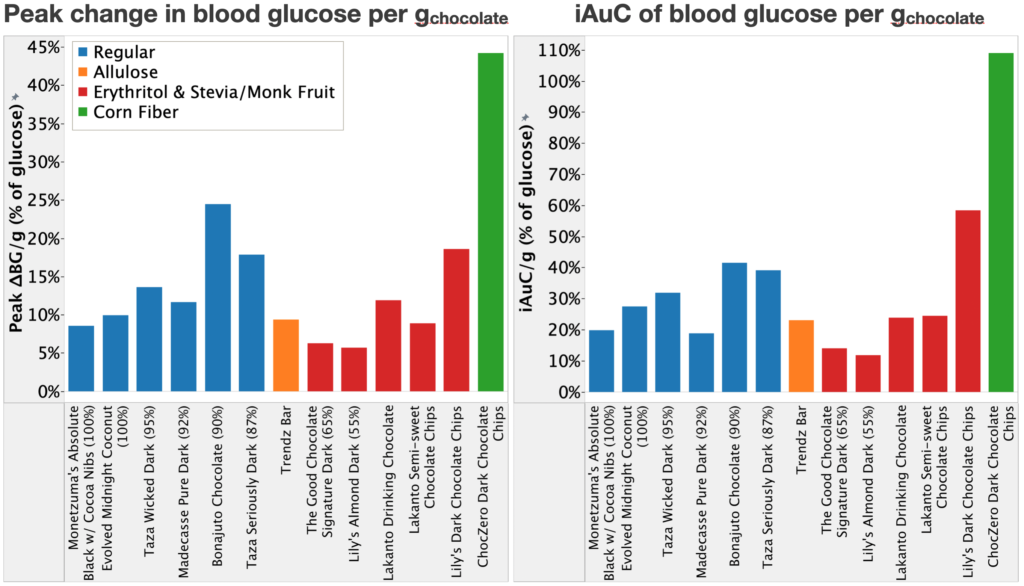
There’s a lot of data here and large variations between categories & brands. To keep things organized, I will split the discussion up by category.
Regular (no non-nutritive sweeteners or added fiber)
Unlike other low-carb foods, chocolate is sold with a wide range of carbohydrate content based on the amount of added sugar. In particular, high cocoa content chocolate can be fairly low-carb, with some 100% cocoa chocolates having net carbs of as low as 8g/100g of chocolate or 8g/600 kcal, which is not much higher than some keto ice creams. Given that, I tested a number of high cocoa chocolates, ranging from 87-100% cocoa.
Overall, the blood glucose impact was what you’d expect from the nutrition labels with the higher cocoa chocolates having a very low impact (peak ∆BG of 9-12% and iAuC of 19-32% of glucose). The blood glucose impact was linearly correlated with the listed net carbohydrates, which is expected as the added carbohydrates are sugar. However, there were a few interesting observations:
- The intercept in peak BG vs. net carbs is much greater than zero, indicating that some of the fiber is metabolized (the protein content is too low to account for the spike.
- Peak BG impact did not correlate with the percent cocoa solids. Based on the nutrition label, this appears to be due to some brands (Bonajuto) adding only sugar as the non-cocoa mass, while others (Taza, Medecasse) adding a mix of sugar and additional cocoa butter.
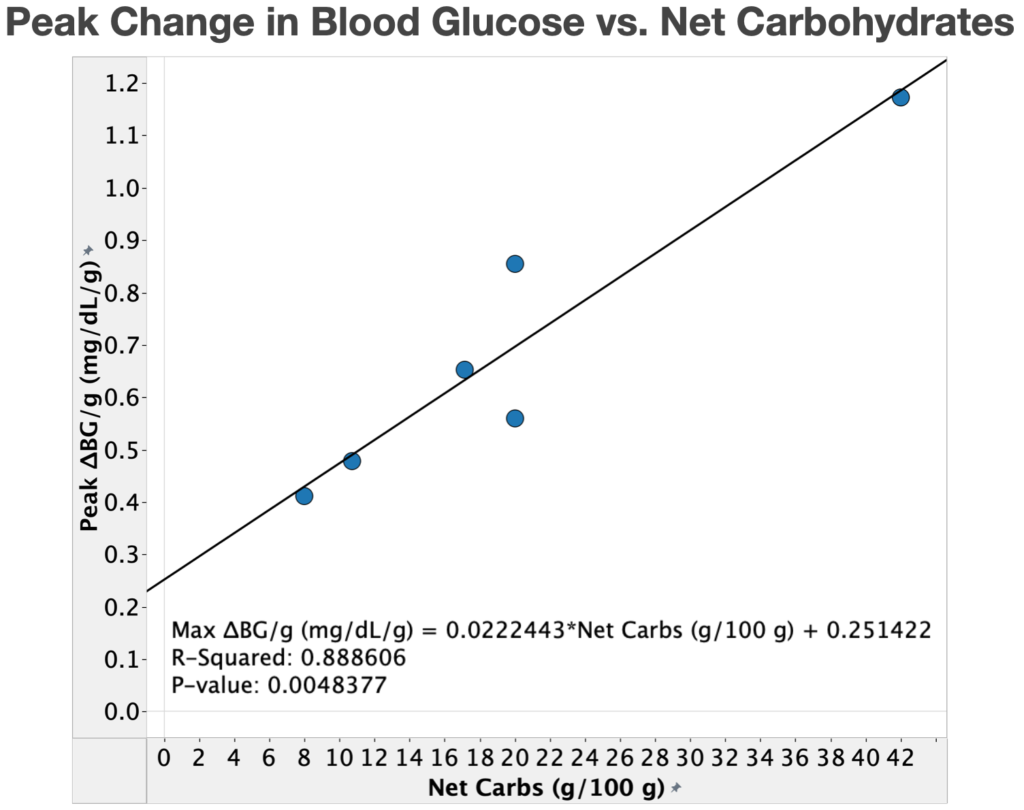
On taste, these were universally a lot better than I expected. The 100% cocoa bars (Montezuma’s & Evolved), weren’t sweet at all, but not nearly as bitter as baking chocolate or other 100% cocoa bars I’ve tried in the past. The lower cocoa bars all were sweet enough for my tastes, even up to 95% cocoa.
Texture was where these got more interesting. The stone ground chocolates (Taza & Bonajuto) had a “gritty” texture that I really liked. According to Taza’s website, this results in a coarser particles and preserves the flavor of the cocoa beans. The coarser size is definitely the case, you can both see and feel the larger sugar crystals in the Taza and Bonajuto bars. As for preserving flavor, the Taza bars have nice “fruity” undertones, but Bonajuto tastes like straight chocolate, while Madecasse (not stone ground) has even stronger undertones than Taza. I suspect the taste is more due to the bean then the grinding process.
All that said, the Taza 95% bar was my favorite from the whole study, having the best combination of taste & texture, while still having a relatively low blood glucose impact.
Allulose & Erythritol Bars
The majority of low-carb/keto chocolate bars substitute erythritol or allulose for the sugar used in regular chocolate. Blood sugar impact of these were fairly low, with peak ∆BG of 6-9% and iAuC of 12-23% of glucose, or ~25-30% less than highest cocoa regular chocolate. Not surprising given that both erythritol and allulose have negligible impact on my blood glucose.
For me, the one standout was the Trendz bar, my second favorite after the Taza 95%. It had a really strong chocolate flavor with really nice tangy & cinnamon undertones. It also had a slightly gritty texture, not as noticeable as the stone ground chocolates, but still provided the heterogeneity that I like. The only downside to this bar was that it wasn’t separated into squares or rectangles, making it a lot harder to eat. Every other chocolate bar I’ve ever had does that; no idea why Trendz doesn’t…
Erythritol Chocolate Chip & Drinking Chocolate
In addition to bars, I also found erythritol sweetened chocolate chips & drinking chocolate.
The chocolate chips had a taste & texture similar to regular chocolate chips, though the Lakanto brand had a noticeable cooling effect from the erythritol. Interestingly, while the BG impact of the Lakanto chips was relatively low (peak ∆BG of 9%, iAuC of 24% of glucose, similar to Trendz), the Lily’s chips had a much higher BG impact than erythritol sweetened, including other Lily’s brand bars (peak ∆BG of 19%, iAuC of 58% of glucose).
Looking at the ingredient list, the main difference between the chips and bars is that the chocolate chips use added fiber, presumably to control texture. This is the only thing I can see that could cause the increased BG impact, though the effect is much larger than I would have expected. More reason I should directly test low-carb fibers.
For drinking chocolate, the only brand I found was Lakanto, which uses a blend of erythritol, dutched cocoa, and tapioca & sugarcane fiber. The blood glucose impact was ok, with peak ∆BG of 12%, iAuC of 24% of glucose. For taste, I found the recommended serving size (16g per cup) to be provide too mild a chocolate flavor, but it was sufficiently strong at 2-3x servings in one cup of almond milk. Unfortunately, though, at that concentration I could taste a noticeable monk fruit aftertaste and the drink was sweeter than I’d prefer. Overall, I think I’d rather make my own drinking chocolate blend and use less sweetener and fibers with lower BG impact.
Corn Fiber
One brand, ChocZero, uses soluble corn fiber instead of erythritol/allulose as the sugar replacement. I’ve had very mixed results with fibers, ranging from almost no BG impact to comparable impact to glucose. For soluble corn fiber specifically, I found one study showing relatively low BG impact (though they didn’t quantify), but many people have seen blood glucose spikes with ChocZero (example).
In my own tests, the ChocZero chips showed the high BG impact by a wide margin, with a peak ∆BG of 44%, iAuC of 109% of glucose and ~2x that of the next highest chocolate I tested.
Taste was better than the other chocolate chip brands, though I didn’t like the soft/chewy texture provided by the high fiber content.
When I mentioned these results on Reddit, some commenters were concerned the high BG impact of ChocZero might be only for diabetics or just a large person-to-person variation. Anyone else willing to test it out?
Thoughts & Next Experiments
Evidence continues to pile up that there’s a large variation in the impact of different fibers, even ones with the same name listed on the nutrition label. I’m going to see whether I can source a decent variety to test.
If anyone knows where to get the fibers and resistant starches that are used in low-carb prepared foods (especially from the actual manufacturers), please let me know in the comments or by PM.
Here’s my overall conclusions:
- Lowest BG impact: Lily’s Almond Dark & The Good Chocolate Signature Dark
- ~65% of the impact of 100% cocoa bars
- Best combination of taste & impact: Taza Wicked Dark & Trendz Bar
- Chocolate with added fiber shows much higher blood glucose impact
- There’s a significant variation between brands
- This could be due to different fiber type or quantity
- Watch out for the ChocZero chocolate, which gave ~2x the BG impact of the next highest chocolate.
As always, please let me know in the comments if you have any thoughts, suggestions, or anything else you’d like to see me test.
– QD
Why not just eat something that’s very high fiber along with the chocolate?
At home:
Anything green (yes that’s weifd before or after chcolate, but that would be HIGH fiber. Ex: a little spinach, etc.
Out at and about / at home a better match than Spinach to go with the chocolate:
A few unroasted almonds or whatever nut has highest fiber / lowest calories.
I haven’t done a ton of experimenting with adding fiber when consuming other macros, but the little testing I’ve done showed only a modest effect (https://www.quantifieddiabetes.com/2020/09/measuring-effect-of-low-carb.html).
Adding 44g of oat fiber to 8g glucose only reduced the BG peak by 20%, with no reduction in area-under-the-curve, indicating a slight slowing of glucose absorption, but nothing enormous. I’m interested in testing this further, especially with macros other than glucose, but haven’t gotten around to it yet.
I was very dismayed with choczero. I have tried several of their bars and if I eat more than one small square I get severely high blood sugars. I’ve been diabetic for a few decades and so am disappointed. I have tried wicked dark Taza but too strong a chocolate. But like their cinnamon round.
Me, too. Researching this is what brought me here. I love their (choczero) chocolate and jams but eating them is as bad as regular sugar on my BG. I am a diabetic as well, and this makes me so sad.
I’m suspecting something’s going on with ChocZero products. I used their keto honey in my tofu quinoa bowl at times when I run out of blue agave syrup, and it my BG would end up high. I though it could be because I had more quinoa than usual in my bowl or some other type of ingredient in my recipe. But I just bought two boxes of ChocZero’s hazelnut truffle – one for my sister as a Xmas gift, and one for me to test to see if it tastes good enough to give to her. We both are diabetic (she’s T2D as far as we know and I’m T1D). My bg went from a 129 to a 189 after eating just two pieces, and I had put in the carb count in my insulin pump.